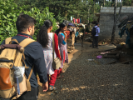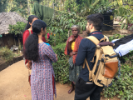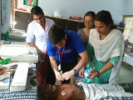A Feasibility Study of Using Wearable Devices for Remote Cardio-metabolic Health Monitoring in a Global Health Scenario

Photo Courtsery of Arsalan Haghdel
According to the World Health Organization, diabetes and cardiovascular diseases are two of the top prevalent non-communicable diseases affecting people worldwide[1].
In low- and middle-income countries, more than 60% of the population resides in remote rural areas where health care is not easily accessible due to a lack of primary care centers and health care resources [2,3]. Individuals with diabetes or cardiovascular diseases have to travel long distances to monitor physiological parameters, which may be inconvenient, time consuming, costly and invasive. Where health disparities in rural areas continue to persist, remote monitoring can aid in improving the health of populations that lack immediate access to health care.
Amrita University’s Live-in-Labs Program provides opportunities for international and local students to take part in projects aimed at improving living conditions of underprivileged rural populations. The Wireless Networks and Applications (WNA) Department has designed a wearable, low power and low cost ECG machine (Amrita Spandanam) and a non-invasive glucose monitor. These devices send data wirelessly via a smart phone interface to the nearest health care facility and hospital information system. Health care providers there can monitor patient information and triage who needs care more immediately. Undergraduate students, Arsalan Haghdel and Aye Bay Na Sa, assisted Amrita University with the deployment of these two devices.
Deployment occurred in three different settings: 1) Amrita Kripa Charitable Hospital serving the tribal population in Wayanad district, Kerala, India 2) Vallikavu Primary Health Center serving the rural population of Vallikavu village, Kollam district, Kerala, India and 3) Amrita Institute of Medical Sciences at Kochi, Kerala, India, a specialty-care urban hospital. The team tested the devices, observed clinic settings, interviewed health care providers and patients to identify the appropriate public health efforts needed for deployment, and analyzed data. Amrita University hopes that this device will help to reduce existing health care disparities in rural and remote populations for millions of people who lack access to health care.
- “Non communicable diseases.” World Health Organization, June 2017, http://www.who.int/mediacentre/factsheets/fs355/en/.
- Rahul Krishnan Pathinarupothi, E.R., Large Scale Remote Health Monitoring in Sparsely Connected Rural Regions.
- Dilraj N, R.K., Rahul Krishnan, Maneesha V Ramesh, A Low Cost Remote Cardiac Monitoring Framework for Rural Regions.
Written by Jessica Scates
- Name(s): Arsalan Haghdel and Aye Bay Na Sa (Biomedical Sciences)
- Mentors: Amrita University Faculty Members
- Country of Travel: India
- Dates of Travel: December 2017-January 2018
Articles and Reflections
Presentations
Images from Arsalan and Aye Bay Na Sa's trip to India
Amrita University’s Live-In-Labs are 101 villages in rural India, where Student Researchers live, assess the local community’s challenges, and apply their educational training in the creation and testing of potential solutions. The central aim of Live-In-Labs is to find ways to integrate education into day to day life, and in so doing, to foster strategic planning (rather than mere survival) in rural communities. To that end, students work in interdisciplinary teams to apply and implement theoretical knowledge.














